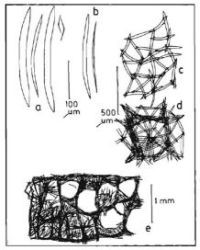black
encrusting
massive
papillated
crumbly
hard
Colombia
Martinique
Panama
United States
Neopetrosia carbonaria
Description: Thickly encrusting to massive, often elongated, generally as thick as wide, up to about 15-30 cm long, 10 cm wide and thick, with dispersed volcano-like oscular elevations, 0.5 to 2-3 cm high; oscules up to 1 cm in diameter, but usually smaller. Masses often occur in groups, sometimes connected by lower bridges, sometimes growing lateral repent branches or erect branchelets. On rubble or sand, they may be half buried, showing the oscules as papillae. Surface even and smooth or microrugose to tuberculated, clean or fouled or covered with sand. Color black to very dark green, internally and externally, maintaining its color preserved and when dry. Consistency firm, crumbly especially in oscules and elevations. Skeleton (from Zea, 1987, as Pellina carbonaria) as thick spicule tracts, 4-15 spicules in cross section and 60-160 µm thick, forming a reticulation of rounded to rectangular to polygonal, 130-650 µm wide meshes, often with loose spicules in confusion. Near the surface, it becomes as ascending and interconnecting tracts, engrossed in steps as growth layers. The ectosome is an isodictyal regular reticulation of single spicules joined by spongin at their nodes, overlying the thicker subsuperficial reticulation. Spicules are robust hastate oxeas, slightly curved, sometimes double bent, and thinner developmental stages, 162-299 µm long and 1.4-21-4 µm wide; sizes in southern Caribbean sites are larger than in northern ones. Where spicules were larger, there was a complement of toxiform raphide microscleres with a central swelling, 22-45 x 0.1-1.2 µm.
Notes: This is a rocky shore to shallow reef species, usually living exposed. It was originally described under genus Spongia, and later under Adocia, Pellina and Xestospongia (see van Soest, 1984; Zea, 1987). The size of the spicules is intermediary between typical Neopetrosia (up to 200 µm long) and Xestospongia (usually larger than 200 µm and reaching more than 400 µm). In the western and northern Caribbean it may be confused with N. rosariensis (Zea & Rützler, 1983), also pictured here, which take a shape of low tube-mounds brown-black in color, often with greenish shades, and may also have branchelets; a detailed comparison of spicules and skeleton of co-existing specimens needs to be made. In the field N. carbonaria could also be confused with coexisting black to dark green specimens of Halichondria melanodocia de Laubenfels, 1936, also pictured here, but can be readily distinguished by the much softer consistency and by the much longer and varied in size oxea spicules of the latter.
Author Reference: (Lamarck, 1814)
Link: World Porifera Database

![<i>Neopetrosia carbonaria</i> <br />[United States, Florida Keys]](mini/00117/02053.jpg)
![<i>Neopetrosia carbonaria</i> <br />[Colombia, Islas del Rosario]](mini/00117/02054.jpg)
![<i>Neopetrosia carbonaria</i> <br />[Colombia, Islas del Rosario]](mini/00117/02057.jpg)
![<i>Neopetrosia carbonaria</i> <br />[Colombia, Islas del Rosario]](mini/00117/02061.jpg)
![<i>Neopetrosia carbonaria</i> <br />[Colombia, San Andrés Archipelago, Serrana Bank (atoll)]](mini/00117/02072.jpg)
![<i>Neopetrosia carbonaria</i> <br />[Colombia, Islas de San Bernardo]](mini/00117/02073.jpg)
